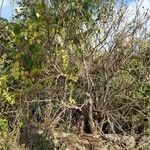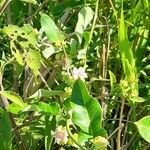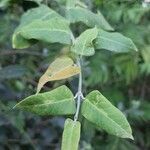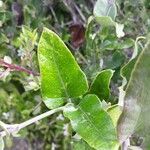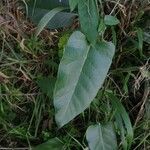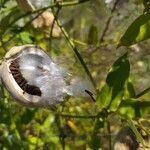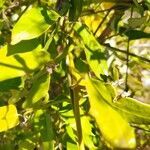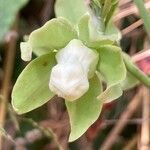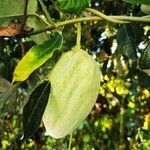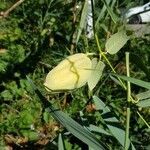Perennial, herbaceous, twining climber, (1-)5-10 m long; basal stems woody; latex caustic. Leaves oblong, 30-100 x (8-)10-34 mm, base truncate, apex acute, tip mucronate, concolorous; petioles 8-16 mm long. Inflorescences: axillary racemes, 2-4(-8)-flowered, clustered; peduncle 9.5-15.0 mm long. Flowers 18-30 x 10-20 mm, white or cream-coloured, tinted pink; fragrant. Sepals large, leaf-like. Corolla: tube campanulate, 8-14 mm long, mouth slightly constricted; lobes 10-20 x 5-8 mm. Corona solid, triangular-ovate, ± 3 mm high, ± 1.5 mm wide, apex obtuse. Style-stigma-head with apex bilobed. Flowering time Sept.-Jan. Fruit solitary, pendent, ovoid, 80-120 x 40-50 mm, surface leathery. Seeds up to 400.
Leaves with lamina lanceolate-ovate, to 8 cm long, to 6 cm wide, truncate at base, acute to shortly acuminate, markedly discolorous; secondary veins 12 or 13 on each side of midrib; colleters 2. Inflorescence of 2–4 fascicles. Flowers 1.8–2 cm long, 2.4–2.5 cm diam.; pedicels 6–13 mm long. Corolla cream or slightly pinkish; tube inflated at base, 14–15 mm long, 7–9 mm diam.; lobes lanceolate, 10–12 mm long, 7–8 mm wide. Staminal corona c. 4 mm long, cream; lobes oblong-rectangular, c. 3 mm long, c. 1.5 mm wide. Follicles 7.5–10 cm long, 3–4 cm wide.
A climbing plant. The stems are twining. The leaves are opposite and grey-green. They are sword shaped with a wavy edge. They are 5-12 cm long by 5-6 cm wide. They are green above and grey-green and hairy underneath. The flowers are bell shaped. They are white or pale pink and 30 mm long. They are in clusters. The fruit are pear shaped. The stalk is at the larger end. The fruit are 6-15 cm long by 3.5-8 cm wide. There are many seeds. The seeds are egg shaped and dark coloured. They have silky hairs attached.
Subwoody climber. Leaves petiolate; blade ovate, up to 50 x 30 mm, base truncate, apex acuminate; upper surface dark green and glabrous above, lower surface paler with a short, dense, whitish pubescence. Flowers: in axillary cymes or solitary; corolla tubular with spreading segments, cream-coloured; Nov.-Apr. Fruit a large spongy capsule, up to 120 mm long; dehiscing down one side.
Subwoody climber. Leaves ovate; base truncate, apex acuminate; lower surface white with short dense pubescence. Fruit large spongy capsule, up to 120 mm long; dehiscing down one side. Flowers cream.
